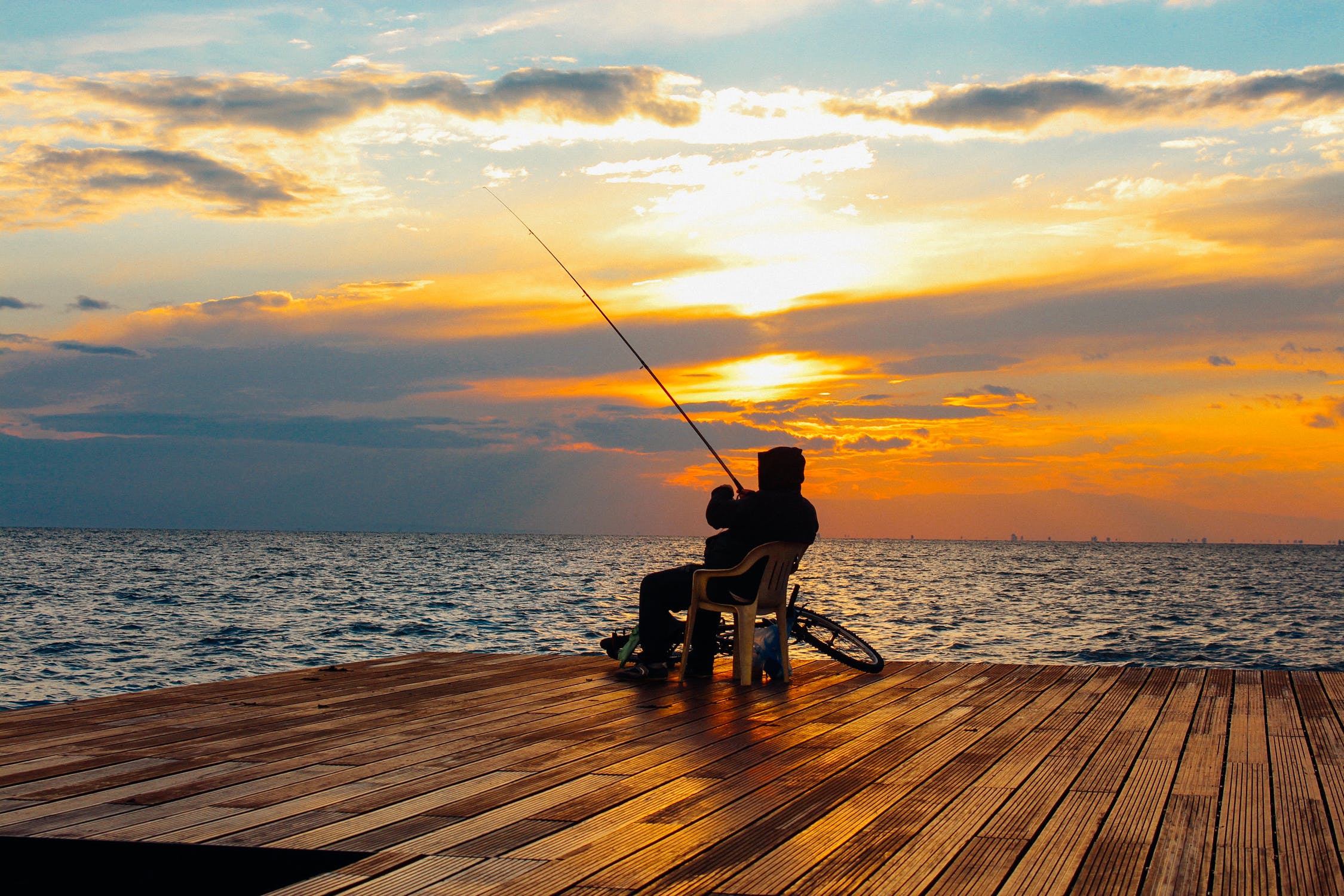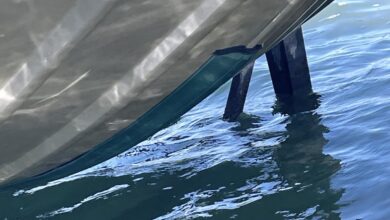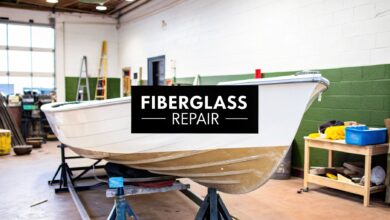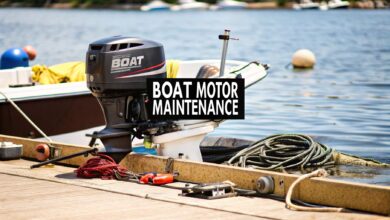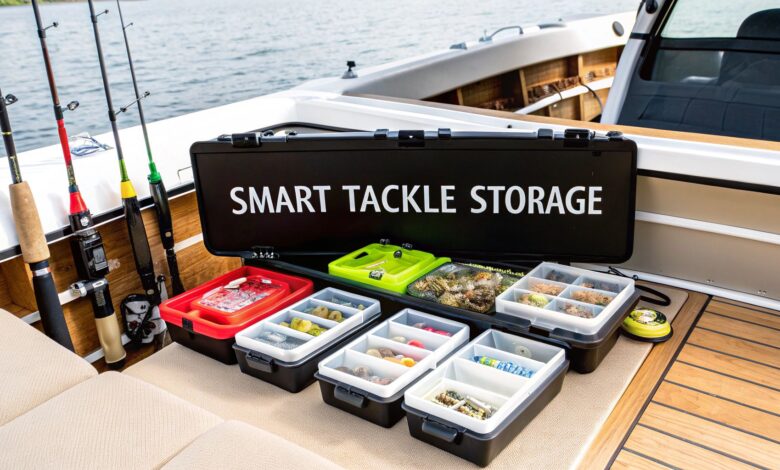
Having your fishing tackle storage dialed in on the boat is about so much more than just keeping things neat. It's about efficiency. It's about protecting your gear. Most importantly, it's about being able to react in that split second when the bite turns on. A smart setup can turn a chaotic deck into a finely tuned fishing machine, keeping your tackle right where you need it, safe and ready to go.
Your Blueprint for an Organized Fishing Vessel
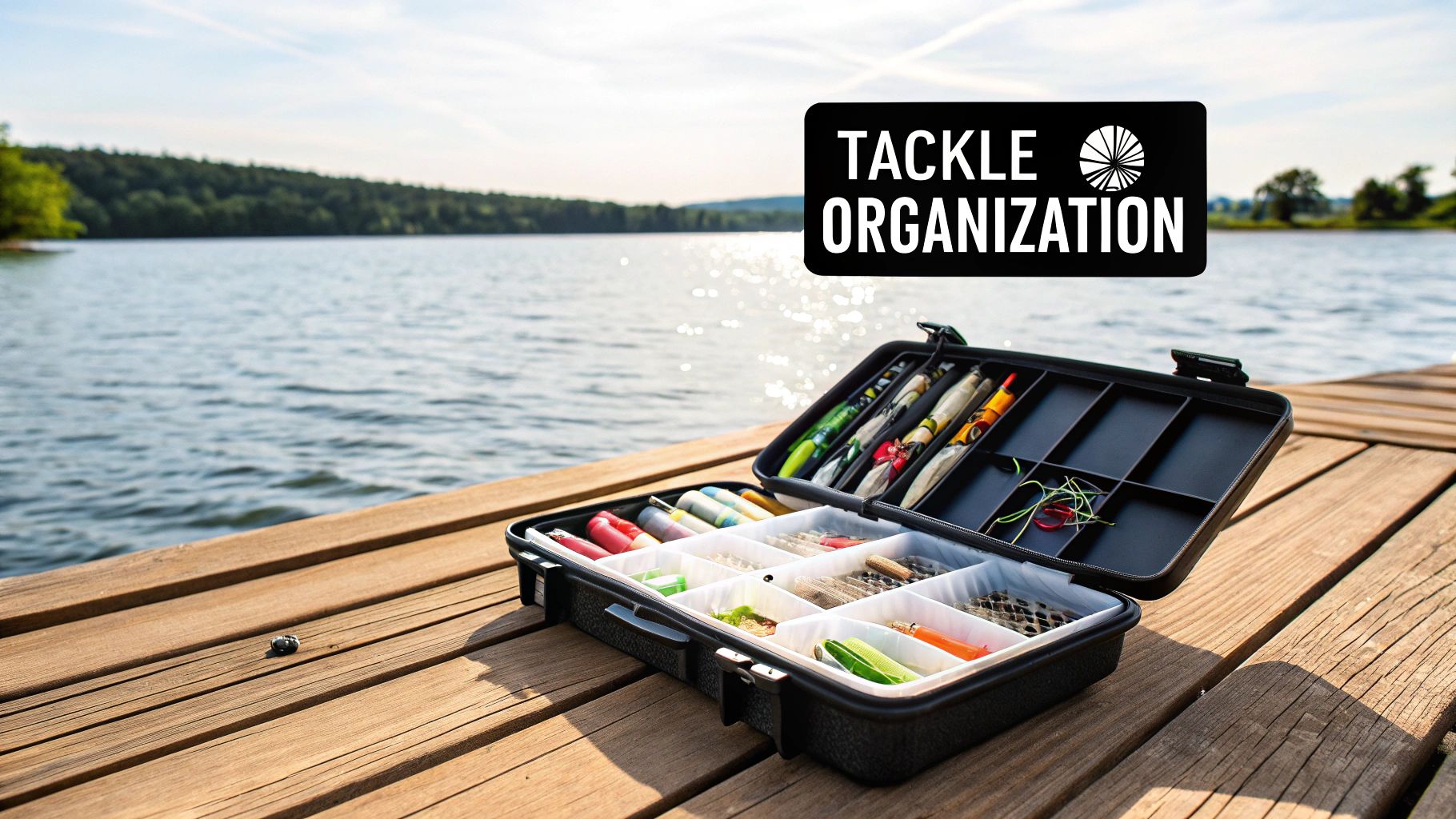
An organized boat isn't just for looks—it’s a performance advantage. Think about it: every moment you spend digging for the right lure or fumbling to untangle a leader is a moment you're not fishing. The real secret to on-boat tackle storage is building a system that fits your boat's layout and, crucially, your personal fishing style.
This goes way beyond one-size-fits-all solutions. Before you buy a single box, take a hard look at how you fish. Are you an inshore angler chasing a couple of key species, or are you an offshore warrior who needs a massive arsenal? Your answer will dictate everything about the storage you choose.
First Principles of Smart Boat Storage
Any great system is built on a few non-negotiable principles. First up is protection. Your boat is a brutal environment. The combination of sun, salt, and constant moisture is hell-bent on rusting your hooks and melting your soft plastics. Your storage needs to be a fortress against the elements.
Just as critical is accessibility. The fanciest lure in the world is worthless if you can't grab it when you need it. The gear you use most—your leader spools, pliers, and a handful of confidence baits—has to be within arm's reach, no exceptions.
"I might be a little CRAZY about tackle storage, but that’s because EFFICIENCY IS WINNING! After 30 years of tournament fishing, I’ve developed a proven tackle organization system that helps me stay efficient, confident, and ready to catch more fish." – Mike Iaconelli, Professional Angler
Key Elements of an Effective System
As you start mapping out your ideal setup, focus on these core concepts:
- Zone Your Gear: Think in categories. Group tackle by the species you're targeting, the technique you're using, or even the water depth you're fishing. You might have one box just for topwater plugs and another dedicated to deep-diving crankbaits for bass.
- Maximize Every Inch: Every boat has hidden real estate. Get creative and look for untapped storage spots inside the console, under casting decks, or along the gunwales.
- Prioritize On-Water Safety: This is huge. Properly secured storage is non-negotiable. In rough seas, a loose tackle box can become a dangerous projectile, putting your gear, your boat, and your crew at risk.
Adopting this mindset changes your boat from just a way to get on the water into an extension of your fishing strategy. It’s all about creating an intuitive flow where every hook, sinker, and lure has a designated home, making sure you’re always ready for that next cast.
Finding the Right Tackle Storage for Your Boat and Fishing Style
Let's be honest: the best tackle storage system isn't the one with the biggest price tag. It's the one that seamlessly fits your boat and, more importantly, how you actually fish. Before you even think about opening your wallet, the most critical step is taking a hard, realistic look at your vessel and your habits. This isn't about daydreaming; it's about building a system that genuinely works in the real world.
The storage needs of a tournament pro's offshore center console are worlds apart from a weekend angler's trusty jon boat. So, grab a tape measure and a notepad and start exploring your boat. Look for every potential storage spot, especially the ones you usually overlook. Check out the unused space under the gunwales, the empty cavity inside your center console, or the area beneath casting decks and seats.
The goal isn't just to find space, but to find usable space. A deep, narrow compartment might be perfect for storing soft plastic bags vertically but useless for bulky utility boxes.
Figure Out Your Fishing DNA
Once you've mapped out your boat's potential, it's time to get personal and analyze your fishing style. A little self-reflection here can save you from buying too much gear or choosing the wrong kind of storage altogether.
Ask yourself these questions:
- What kind of angler are you? Are you a minimalist who brings just enough for the day's target? Or do you like having a massive arsenal on hand for any scenario? Your answer dictates the sheer volume of storage you'll need.
- How often do you change targets? If you're the type to switch from bass to crappie in the same trip, you need a modular system. Think individual, clearly labeled utility boxes you can swap in and out on the fly.
- What's your go-to gear? We all have that core set of lures, hooks, and tools we reach for constantly. This "A-Team" tackle needs to be in the most accessible spots for those moments when the bite is hot and you can't afford to fumble around.
Thinking this way lays the groundwork for a truly efficient setup. It’s a simple, three-part process to get you organized.
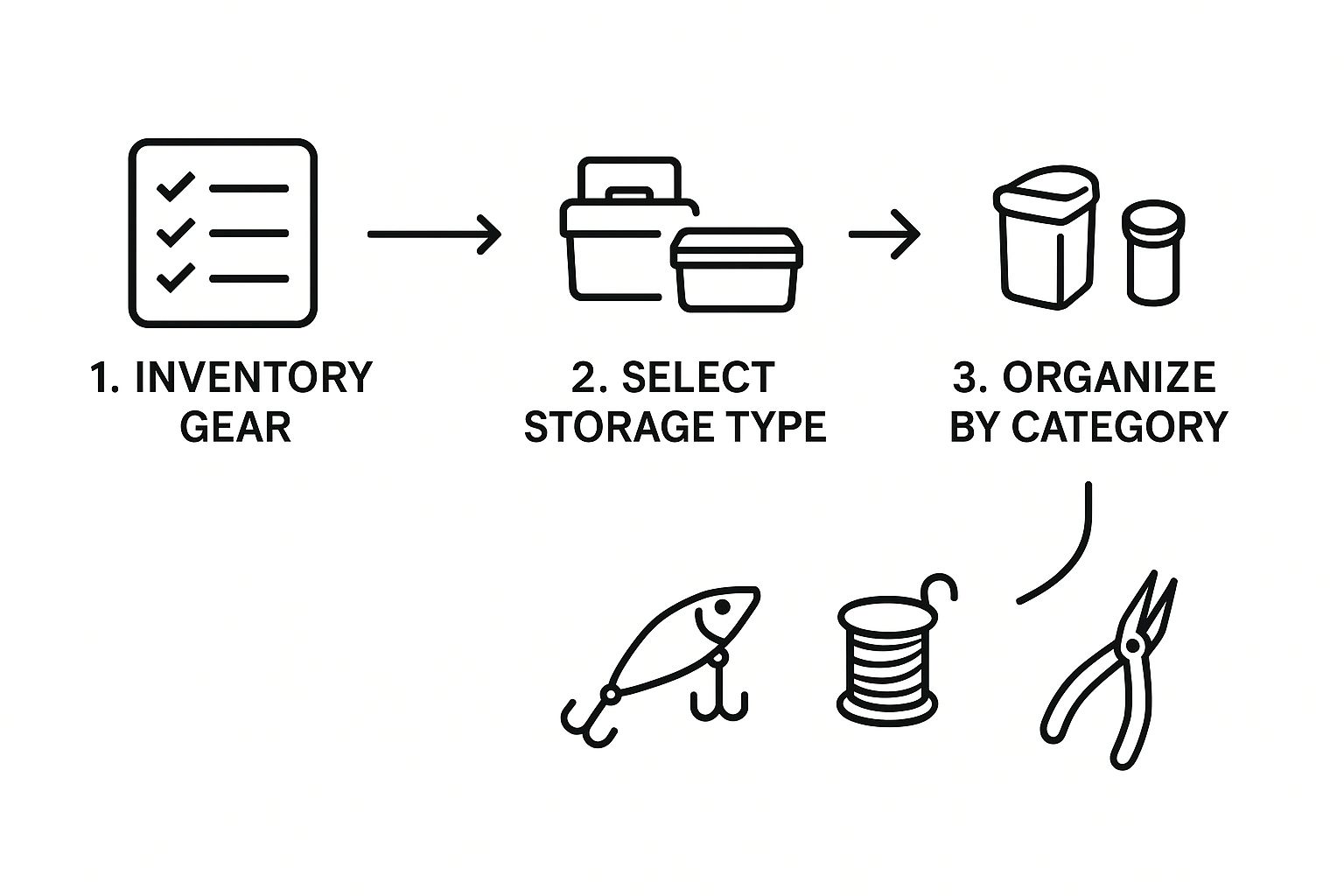
As you can see, smart organization starts with knowing what you have before you ever buy a single box. It’s a workflow that moves from assessment to action.
By matching the physical space on your boat with the reality of your fishing style, you create a personalized system that just works. This deliberate approach ensures you build a fishing tackle storage solution that makes your time on the water better, not just more cluttered.
Choosing the Right Marine-Grade Tackle Systems
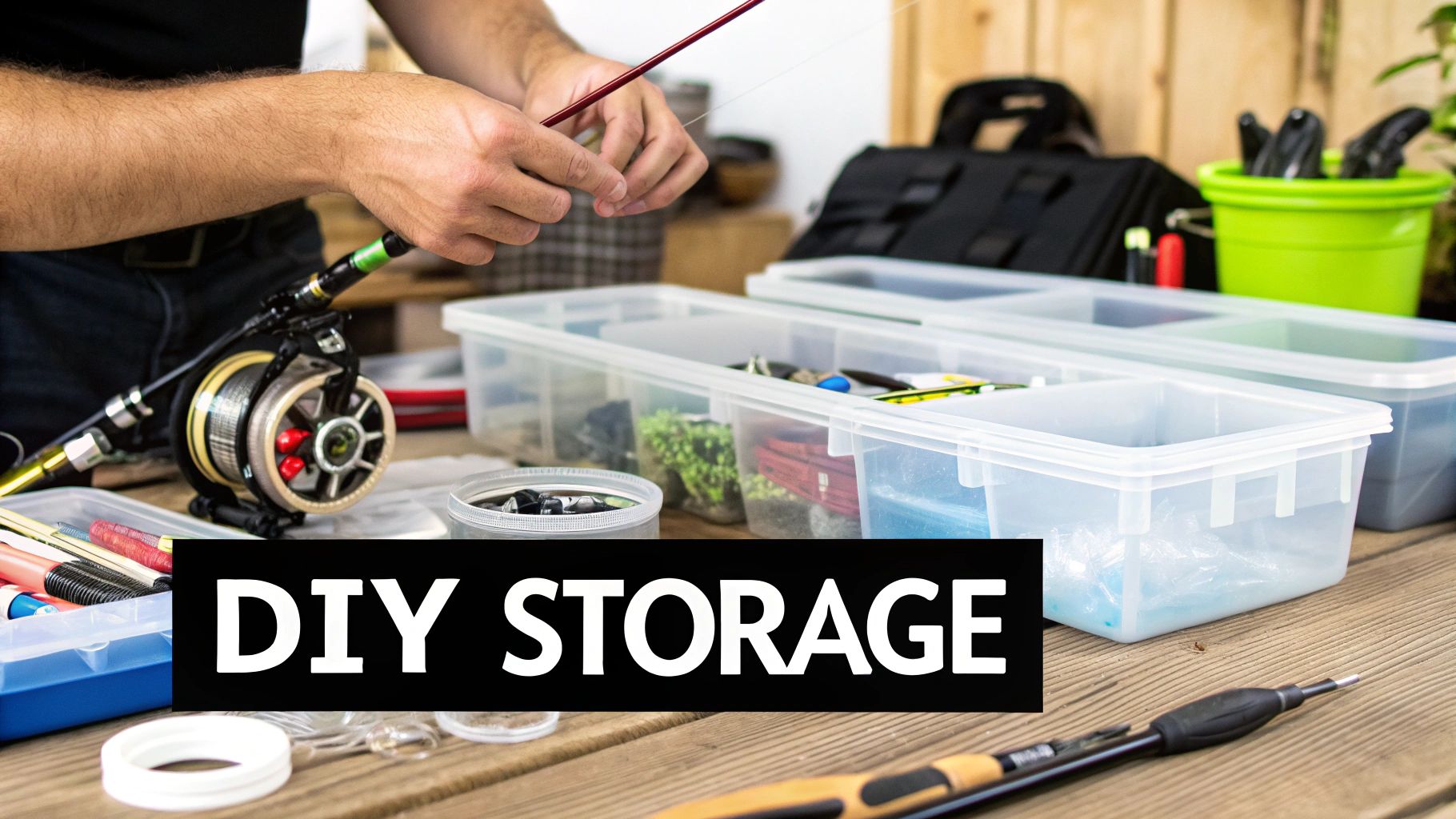
Alright, you’ve mapped out your space and figured out what you need. Now for the fun part: picking the actual gear. When you start shopping for fishing tackle storage, you'll see a dizzying number of options, but for anyone who fishes on a boat, the list gets much shorter. The single most important factor is its ability to survive the marine environment.
The first big decision usually comes down to hard-sided versus soft-sided storage. For your main onboard storage, I almost always recommend hard-sided boxes. There’s simply no substitute for the crush protection they offer for your expensive lures. More importantly, a good hard box creates a much better waterproof seal, which is your best defense against corrosive saltwater.
That's not to say soft bags don't have their place—they absolutely do. They’re fantastic for building specific "go-kits," like a small bag just for inshore fluke tackle or another for offshore trolling gear. They can also be squeezed into those awkward, oddly-shaped compartments where a rigid box just won't go. Many seasoned anglers I know use a hybrid system: they'll bring a larger soft bag to the boat, but inside it are several smaller, hard-sided utility boxes.
Materials Matter Most
When you're holding a tackle box in the store, pay close attention to what it's made of. This is where manufacturers cut corners, and it makes all the difference. Cheap plastics will get brittle and crack after a season of sun exposure, and any hardware that isn't stainless steel will turn into a rusty, seized-up mess before you know it.
Here’s what you should be looking for:
- Marine-Grade Polymers: Quality boxes are molded from tough polymers specifically designed to stand up to UV rays and hard knocks.
- Stainless Steel Hardware: Every single latch, hinge, and screw must be marine-grade stainless. If it's not, it will rust, and it will fail.
- Waterproof Seals: Look for a rubber or silicone gasket running along the inside lip of the lid. When you close the latches, this gasket is what creates a truly waterproof barrier.
Think of it this way: buying a quality system isn't an expense; it's insurance for your tackle. I've seen it happen countless times—a single rusty treble hook can bleed rust all over an entire tray of lures, ruining hundreds of dollars worth of gear in one go.
The demand for better, tougher gear has exploded. The market for fishing tackle bags alone was valued at around $1.2 billion in 2023 and is on track to hit nearly $2.3 billion by 2032. It just goes to show how many anglers are realizing that purpose-built gear is worth the investment.
Specialized Storage Solutions
Once your primary boxes are sorted, you can look at some of the more specialized units that solve very specific, and very annoying, problems. These aren't must-haves for every angler, but for some, they are absolute game-changers.
Leader Spool Boxes
If you’ve ever had a spool of expensive fluorocarbon unwind itself into a bird’s nest inside a dark compartment, you’ll appreciate these. They’re purpose-built containers that keep your leader spools neatly organized and protected from UV rays, which can weaken the line over time. Most allow you to dispense line directly from the box without tangles.
Bulk Lure Hangers
For the offshore crowd trolling big plugs or musky hunters with huge swimbaits, hanging storage is the way to go. These systems, which you can mount inside a large hatch or on the side of a console, let big lures hang freely. This not only prevents tangled hooks and chipped paint but also allows them to air dry properly, which dramatically cuts down on rust.
Ultimately, picking the right system is about making a smart investment in gear built for the long haul. When you prioritize durable materials and match the type of storage to the kind of https://boating-articles.com/tag/fishing/ you do, you’ll end up with a setup that serves you well for many seasons to come.
Installation and Customization That Lasts
Getting your fishing tackle storage properly installed is what separates a truly professional setup from a temporary, rattling mess. This isn't just a matter of driving in a few screws. We're talking about protecting the long-term integrity of your boat. One sloppy hole can lead to water intrusion, which is every boat owner's worst nightmare.
When you're drilling into a fiberglass hull, you have to treat every single hole with respect. Each one is a potential entry point for water if you don't seal it right. The professional method is simple, but absolutely essential: after drilling your pilot hole, use a slightly larger bit or a countersink bit to just barely chamfer the edge of the hole. This small step prevents the gelcoat from cracking under the pressure of the screw head.
Then, before you drive that screw in, get yourself a tube of high-quality marine-grade sealant. Something like 3M 5200 or a similar polyurethane adhesive is perfect. Fill the hole completely with the sealant. As you tighten the screw, the excess will squeeze out, creating a perfect waterproof gasket that seals the raw fiberglass core from any moisture. It’s a tiny bit of extra effort that makes a world of difference.
Choosing Your Mounting Hardware
The hardware you choose is just as critical as your installation technique. Don't even think about grabbing a box of screws from the local hardware store. Standard steel will rust in a heartbeat in the marine environment, leaving ugly, weeping stains on your beautiful deck.
Your one and only choice should be 316 stainless steel for every screw, bolt, nut, and washer you use. This specific marine-grade alloy is far more resistant to corrosion than the more common 18-8 stainless. Yes, it costs a little more, but that extra dollar or two is nothing compared to the cost and frustration of dealing with snapped bolts and rust streaks down the line.
Here's a rule I live by on my boat: If it’s being permanently mounted, it gets sealed and secured with marine-grade hardware. No exceptions. This is about protecting both your expensive gear and the boat itself.
Smart Non-Permanent Solutions
Of course, not everything needs to be bolted down for good. Sometimes you need flexibility, especially if you fish from different boats or just want to change your layout for different trips. Luckily, there are some great non-permanent options out there that are surprisingly solid.
- Industrial-Strength Suction Mounts: Forget those cheap little suction cups from the dollar store. Modern marine suction mounts are beasts, capable of holding serious weight. They’re fantastic for sticking tool holders, leader spools, or small utility boxes onto a smooth console or gunwale.
- Secure Strap-Down Systems: Got a milk crate packed with surfcasting plugs or a big soft-sided tackle bag? Use high-quality cam buckle straps or heavy-duty bungee cords to lash it to existing cleats or railings. This is crucial for keeping heavy gear from turning into a dangerous projectile when the water gets choppy.
By mixing thoughtfully installed permanent storage with these smart, flexible solutions, you can build a truly custom layout that fits your exact needs. The end goal is a clean, hyper-functional fishing machine where every piece of tackle is secure, protected, and right where you need it, when you need it. That's how you get fishing tackle storage that performs as good as it looks.
Organizing Tackle for Peak Fishing Efficiency
Now that your new storage systems are installed, the real fun begins. This isn't just about stashing gear out of the way; it's about creating a battlefield-ready system that lets you react instantly when the bite is on. A well-organized boat truly is the secret weapon for catching more fish.
The goal is to move past the "everything in one giant box" approach. You need a system so intuitive that you can grab the exact lure, leader, or tool you need without even thinking about it, especially when chaos erupts on deck.
The Power of Zoned Storage
I've found the most effective way to organize gear is by creating "zones." Forget a generic "lure box." Instead, you dedicate specific boxes and areas to specific scenarios. It builds a mental map that lets you adapt to changing conditions on the fly.
Think about organizing your utility boxes this way:
- By Target Species: Have a dedicated box for bass, another for crappie, and maybe a third for your catfish gear.
- By Fishing Technique: This is my personal favorite, especially for tournament fishing. Group all your topwater plugs in one box, your jigs in another, and all your drop-shot gear in a third. It's incredibly efficient.
- By Water Depth or Structure: You could have a "skinny water" box for working the flats and a separate one loaded with deep-diving crankbaits and heavy jigs for targeting offshore ledges.
This approach turns your fishing tackle storage from a simple container into a strategic part of your arsenal. When your buddy says the fish are stacked on deep rock piles, you’ll know exactly which box to reach for without hesitation.
Pro Tips for Intuitive Organization
A few small habits can make a massive difference in your efficiency on the water.
- Color-Code Your Boxes: Use different colored utility boxes or even just a strip of colored electrical tape to create a visual shortcut. Maybe red boxes for crankbaits, blue for soft plastics, and yellow for all your terminal tackle.
- Embrace Clear-Top Containers: I can't stress this enough—always opt for boxes with clear lids. Being able to see what's inside at a glance saves precious seconds you'd otherwise waste popping open every single box.
Your organization system is your on-deck playbook. Every second you save by not searching for a lure is another second your line is in the water, increasing your odds of getting that next bite.
The evolution of tackle boxes themselves shows how critical this is. They’ve gone from simple trays to highly specialized systems, becoming a key part of a global fishing gear market that surpassed $18 billion in 2025. Modern boxes with modular compartments and waterproof seals are all designed to keep anglers organized and ready. You can see more about the fishing tackle box market trends on cognitivemarketresearch.com.
The Non-Negotiable Post-Trip Routine
Finally, let’s talk about the most overlooked—and most critical—part of staying organized: what you do after the trip. Taking just a few minutes at the dock or in your driveway will save you hours of headaches later.
Make this post-trip checklist a mandatory habit:
- Rinse and Dry: Give any lures that saw action a quick rinse with fresh water. Let them air dry completely before you even think about putting them away.
- Open and Air Out: Crack open all of your utility boxes, even the ones you think stayed dry. Trapped humidity is the #1 enemy of hooks and the primary cause of rust.
- Restock and Reorganize: Put every single thing back in its designated home. If you lost your last good chatterbait, make a note to buy more right then and there.
This simple routine is what separates the pros from the amateurs. It ensures you’re always ready for the next trip at a moment's notice. For more smart ways to maximize your boat's space, check out our other guides on boat storage solutions. A clean, organized, and rust-free tackle collection means you start every fishing day with total confidence.
Answering Your On-Boat Tackle Storage Questions
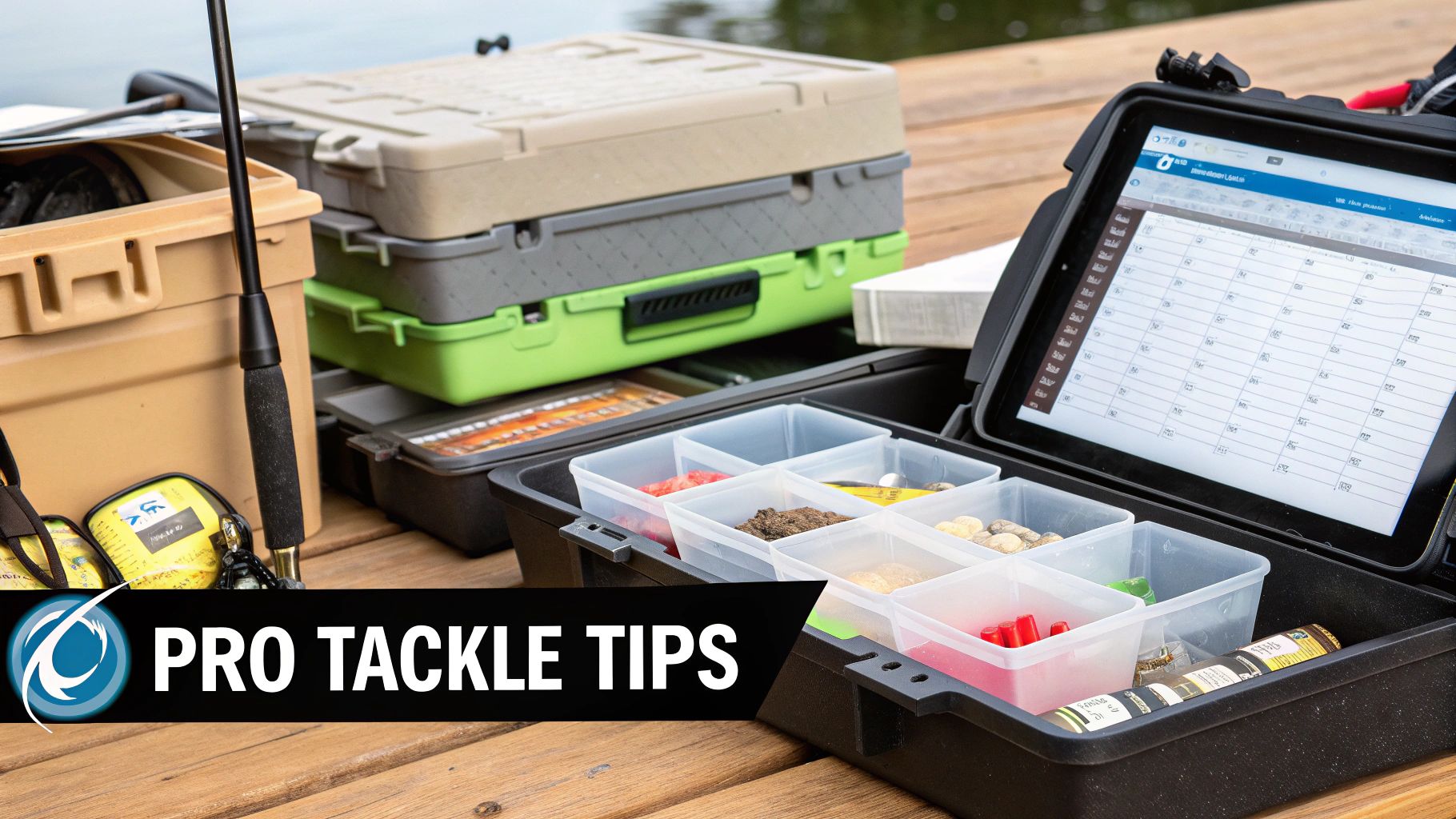
Even after you've made a plan, some questions always pop up when you start putting it all together on the boat. I've been there. Getting these things sorted out now will save you a ton of headaches and money down the road. Let's dig into some of the most common questions I hear from other anglers.
First and foremost, everyone wants to know how to stop rust. Nothing’s worse than opening a box to find your favorite hooks and lures covered in corrosion. The best defense is a simple, two-pronged attack. First, invest in truly waterproof or at least highly water-resistant tackle boxes with quality seals. Second, get into the habit of opening up your boxes to air them out after every single trip. Don't skip this, even if you think they stayed bone dry.
Want to take it a step further? Toss a desiccant pack or one of those VCI (vapor corrosion inhibitor) chips into each utility box. A quick freshwater rinse and dry of any lures you used before putting them away will also work wonders for keeping your gear in top shape for years.
Hard Boxes vs. Soft Bags: Which is Right for You?
The classic debate: hard-sided tackle boxes or soft-sided bags? Honestly, there’s no single right answer. It really comes down to your boat, your storage space, and how you like to fish.
- Hard Boxes: These offer unbeatable crush protection for your expensive lures and are almost always more waterproof. They’re perfect for your primary tackle that lives on the boat full-time.
- Soft Bags: The big advantages here are flexibility and weight. They can be squeezed into tight or oddly shaped compartments, and they tend to stay put better than a slick plastic box when the water gets choppy.
Many of us old hands end up using a hybrid approach. I'll often carry a main soft bag to and from the boat, but inside that bag are several hard-sided utility boxes, each sorted by lure type or species. It’s the best of both worlds.
How to Get Organized on a Tight Budget
You don't need to drop a fortune on custom storage to get your gear in order. Some of the best solutions are the simplest. For instance, heavy-duty zip-top bags are fantastic for keeping soft plastics sorted by color and style.
I've seen guys secure sections of PVC pipe inside a milk crate to create an incredibly effective and cheap holder for lures and tools. It works! And for handling your catch, you can learn more about the benefits of a fish kill bag, which can save you space and keep fish fresh without a big, expensive livewell.
The most critical, zero-cost step you can take? Labeling everything clearly. Pick a system, whether it’s with a marker or a label maker, and stick with it. That consistency is what really makes a difference.
